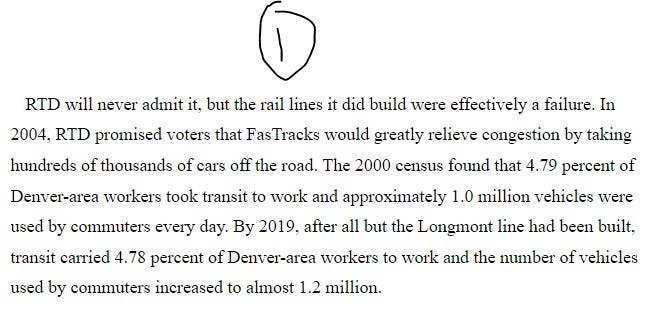Given FasTrack's failure, is Front Range Rail a good idea? Gov't spending on migrants. Now that it's November, a friendly reminder: vote.
Given the experience that people up near Boulder have had with RTD and the FasTracks failure, should we really be investing in Front Range Rail?
In 2004 RTD made some big promises to the folks up near Boulder/Longmont regarding trains and buses that would be on budget, on time, and remove tons of cars from the roadways. See the blog post linked first below for more details.
Sound familiar?
Our state government in 2021 created yet another (I know I've felt like there aren't enough haven't you?) taxing district which will be charged with building passenger rail to run up and down the I-25 corridor to, wait for it, remove tons of cars from the roadways. See the second link below.
From what I've seen the Front Range rail folks have sense enough (once bitten twice shy?) to at least not promise a timeline or money yet. If I find claims they make, I'll send them along.
In the meantime, we have history and experience to teach us.
Screenshot 1 attached (from the blog post) says it more eloquently than I can: FasTracks is and was a failure. This makes my hopes dim that a similar line along I-25** will be better. Even assuming they can avoid the cost overruns and delays (just a reminder that folks are STILL waiting on a promised line out of Longmont), can we figure that the habits of the humans will change?
That is, can we expect a huge number to take trains and empty out I-25? The numbers in screenshot 1 make that doubtful. I would say that wise planning would include surveys, but even then I am somewhat doubtful. People SAY all kinds of things and then DO others.
I am just grateful that I don't live in a district that would tax for this. If you do and this is a passion or a concern, I would recommend taking this up with your local government elected officials (city/county). Get with them and share your thoughts.
I also reached out to the Front Range Passenger Rail district to ask about opportunities for public engagement. As of this writing I've not heard back. I will update if I do.
One last thing to leave you with.
Read the quote in screenshot 2 from the blog post. I thought this particularly apt and also generalizable. Indeed, when government people (elected or no) make decisions about what to build, it's important to remember that their incentives don't match those of a normal family or business: they're not paying with their own money and their rewards come from the political considerations.
**And now I'm hearing buzz about a line from NW Colorado to the Front Range touted as yet another environmentally-friendly alternative to cars and also a chance to put the former coal miners and powerplant employees from NW Colorado to work.
https://ti.org/antiplanner/?p=21539#more-21539
https://www.frontrangepassengerrail.com/frpr-about#:~:text=Senate%20Bill%2021%2D238%20created,District%20began%20July%201%2C%202022.
And while we're on the topic of government spending your money and incentive structures ...
The conservative-leaning Common Sense Institute recently released a report on the cost of sheltering and supporting the migrants that are overwhelming our Southern border. The intro web page (with a link to the study proper) are below.
I will leave it to you to read up in as much detail as you'd like, but there were two things that really stuck out to me, the things that I personally care about the most (outside of our nation's security which is not addressed in this study that is): the cost and who pays.
Take a look at screenshot 1. It shows the total spending (red line) and the total number of migrant arrivals (blue line) with a projected increase in the bit of grey on the right side of the graph. The bifurcation in the red and blue lines show a high projection and a low.
Denver has already spent above $25 million and, at the low projection, can figure on $10 million more by the end of the year.
Yep.
And where is this money coming from?
If you look in screenshot 2, you'll note that so far a lot of the cost is coming from emergency contingency funds and private donations, but we will soon hit a point where the money to do this without shorting something else will run dry. That is on top of the fact that we could still have some other contingency to deal with that would also need our contingency funds.
I'm reminded here of a family that is paying for something out of their savings account and keeping their fingers crossed that the water heater or some other big expensive appliance doesn't break. If you're living in Denver yourself, I suggest you keep your fingers crossed too.
https://commonsenseinstituteco.org/denver-migrant-sheltering/
Vote
Since Halloween's behind us and it's officially now November, this is a reminder to vote.
Vote in person. Turn in your ballot directly to your clerk. Drop it in a drop box. Mail it in.
Vote the same way I do. Vote completely opposite.








Every time I see proposals for rail going along both I25 and I70 I think, well, how much ridership is the Bustang getting to these areas. I understand Bustang is pretty comfortable with WIFI and other convinces. Who needs a study when you have a pretty good indicator of ridership right there. Maybe a train would increase a little but unless Bustang is making money, more expensive rail would lose even more!